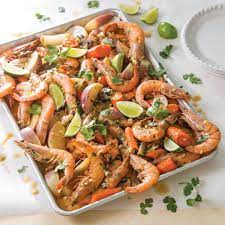Vietnamese cuisine is known for its diverse and flavorful dishes, and seafood plays a big role in the country's culinary tradition. Shrimp is one of the most popular seafood ingredients in Vietnam, and it is used in a wide variety of dishes. But one question that might come up is whether or not Vietnamese people peel shrimp before cooking or eating them. The answer is yes, it is common for Vietnamese people to peel shrimp before cooking or eating them.
Shrimp is a versatile ingredient that can be used in many different ways in Vietnamese cuisine. It is often used in dishes such as shrimp spring rolls (nem ran), which are popular appetizers or snacks. These rolls are made with thin rice paper wrappers filled with a mixture of shrimp, herbs, and other ingredients. The shrimp is usually peeled before being added to the rolls, making them easier to eat and ensuring that the shrimp is clean and safe to consume.
Another popular dish that features shrimp is shrimp salad (goi tom), which is a refreshing and light dish that is perfect for the hot and humid weather in Vietnam. The shrimp is peeled, cooked, and then mixed with a variety of herbs, vegetables, and a tangy dressing. This dish is often served as a side dish or as a light lunch option.
Shrimp noodle soup (bun tom) is also a popular dish in Vietnam, and it is a comforting and satisfying meal. The shrimp is peeled and cooked before being added to the soup, which is made with a flavorful broth, rice noodles, and various herbs and vegetables. This dish is often enjoyed as a breakfast or lunch option.
Peeling shrimp before cooking or eating them can also make them more enjoyable and easier to eat. The shell and any unwanted debris can be removed, ensuring that the shrimp is clean and safe to eat. Additionally, many traditional dishes may require the shrimp to be deveined and peeled, like the shrimp paste (mam tom) where the shrimp are grounded and mixed with salt, sugar, and other spices to create a fermented shrimp paste. This paste is used as a base for many traditional dishes and it is an essential ingredient in many Vietnamese households.
In summary, it is common for Vietnamese people to peel shrimp before cooking or eating them. Shrimp is a versatile ingredient that is used in many different dishes, and peeling it before use ensures that it is clean, safe to consume, and easy to eat. Additionally, traditional dishes may require the shrimp to be deveined and peeled, like the shrimp paste (mam tom), which is an essential ingredient in many Vietnamese households. Vietnamese cuisine is known for its diverse and flavorful dishes, and seafood plays a big role in the country's culinary tradition. And shrimp is one of the most popular seafood ingredients in Vietnam, it is enjoyed by many, and it is a vital part of the Vietnamese food culture.

